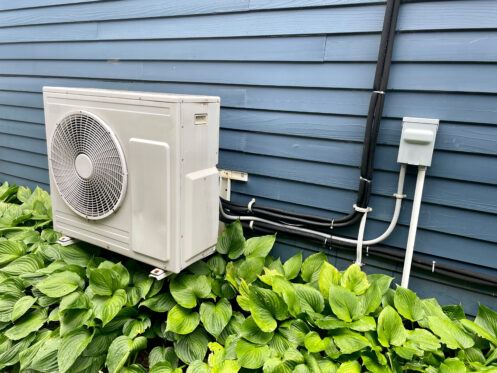A ductless mini-split system is a heat pump with an outdoor unit and individual indoor air handlers in each conditioned space. It has an electric motor and fans and functions as an air conditioner and a heater, transferring heat in and out of rooms through the use of refrigerant. It uses very little electricity since it does not burn fossil fuels or heat an element. Is it a good fit for your home in Gurnee? Here are some additional facts to help you decide.
How a Heat Pump Works
Heat naturally flows from hotter to colder areas, which is the basic principle underlying the heat pump. In the summer, cold refrigerant absorbs heat from a warm room, compresses until it is very hot, and releases the radiant energy to the cooler outside environment. In the winter, the cold refrigerant absorbs heat from the external environment, compresses until it’s even hotter, and travels indoors to release the heat into the cold rooms.
Heat Sources
Heat pumps can absorb heat from the air, underground, or water in the colder months. The first two are the most common, and we cover them here.
Air
Air-source installations are cheaper than placing pipes underground. In many models, they are only practical as a stand-alone heating solution when the temperature is above freezing. Otherwise, there’s an insufficient amount of radiant energy to absorb.
However, newer technologies have recently entered the marketplace, allowing mini splits to operate at 100% efficiency in temperatures as low as 5 degrees Fahrenheit. If you want to learn more about these brands, contact Modern Heating and Plumbing for additional information.
Low temperatures don’t mean an air-source heat pump is unsuitable for Gurnee, a city where temperatures frequently fall below freezing. Heat pumps can work with your furnace and supply heat when the temperatures are sufficiently high; when it’s colder, the furnace automatically takes over. That will save you money on fuel, but you’ll need to counterbalance that against the purchase and installation cost of a heat pump system that can also cool your home.
Geothermal
Geothermal installations lay pipes horizontally in a 4-to-10-foot trench that can take up considerable space or vertically in a borehole 150-to-500 feet deep. Horizontal installations are cheaper but require a lot of space and soil suitable for digging. If it’s too rocky, this might not be an option.
The ground maintains a reasonably constant temperature starting at a depth of 4 feet or when you get below the frost line. The Illinois geothermal temperature stays about 55 degrees Fahrenheit, suitable for a heat pump’s operations.
Mini-Split Systems
Heat pumps can use ducts and provide centralized conditioned air through vents. When a heat pump does not use ducts, it’s called a mini split. Both types can be air-sourced or geothermal. You might not want to incur the cost of a ductless system in a home with ducts unless that ductwork is old and needs replacement. However, mini splits are excellent for ductless new construction, room additions, garages, and workshops.
Mini-split systems have one or more indoor air handlers and an outdoor unit containing the compressor and condenser. A small hole in an external wall allows the tubing to connect each air handler with the outside unit. The largest available system can accommodate eight air handlers. You can buy another appropriately sized outside unit with additional air handlers if you need more.
Zoning
One of the significant advantages of a ductless mini split is the ability to set the temperature in separate rooms without the expense of energy-inefficient electric baseboards. Each air handler is mounted on the wall, above the floor or ceiling, and has its own temperature sensor and remote control. Some can even provide temperature and airflow based on the number and location of people in a room.
Zoning is a great way to keep occupants comfortable. Although the temperatures in the shared living spaces may cause some disputes, you can set the temperature in your private areas to whatever is most suitable for you.
Improved Indoor Air Quality
Each air handler has its own HEPA air filter. HEPA is a higher-quality filter than what you will find in a traditional HVAC system. That’s because more effective filters have smaller holes in the mesh to trap viruses and bacteria as tiny as 0.3 microns. In a central HVAC system, holes that size would not allow sufficient airflow into the ducts. Since there are no ducts in a mini system, that’s not a problem.
Another reason the air is cleaner in a mini-split environment is the fact that there are no contaminants from ducts entering the rooms. We recommend scheduling duct cleanings every three to five years, but some property owners never clean them. Anything that bypasses the air filter or enters through an opening in the ductwork may settle in the ductwork. This detritus can include bacteria, viruses, mold spores, and animal droppings. As air flows over this debris, it may pick up and carry unhealthy particulates through an air vent. This won’t happen with a mini-split system.
Efficiency
A traditional HVAC system loses heat as conditioned air travels through poorly insulated or leaky ducts. Because a mini split is a ductless system, this type of inefficiency does not occur. There is also no wasted energy, which happens anytime you burn fossil fuel, such as gas or oil. Experts estimate that some mini-split systems have an efficiency rating of 300%, meaning they generate three times more energy than they use. ENERGY STAR-certified mini splits are the most efficient models, and we suggest that you consider these first before deciding on a system. In general, you can expect to save 30% to 40% annually in energy costs with a mini-split system.
You can’t plug it in and ignore it if you want to maintain such a high efficiency level. You’ll need to change dirty air filters and schedule a maintenance visit at least once a year to keep the system running optimally.
Tax Credits and Rebates
The federal Inflation Reduction Act provides property owners with a tax credit equaling 30% of the total cost of a mini-split system up to $2,000. ENERGY STAR offers a rebate when you purchase an air-source mini split. In addition, several Illinois utility companies offer substantial rebates when you purchase a mini-split system. Do your homework before you buy, and watch your savings grow!
Modern Heating and Plumbing has provided local service to residents of Gurnee, IL and the surrounding areas since 1948. Our factory-certified technicians offer excellent and timely residential and commercial heating and cooling maintenance, repair, and installation services. We are a Better Business Bureau Accredited Business, providing 24/7 emergency service for HVAC and plumbing repairs. Before you purchase a mini-split system, call or drop by our office to discuss your options. We may even be able to provide you with information on the latest rebate offers. Contact Modern Heating and Plumbing today for all your HVAC and plumbing needs!


